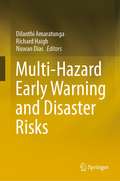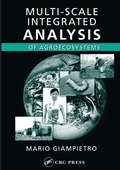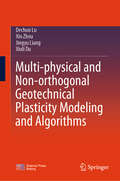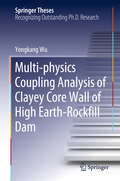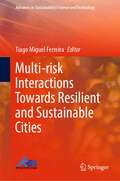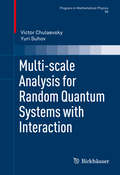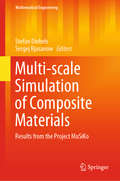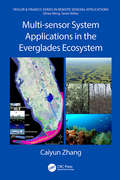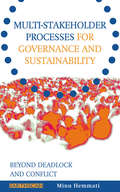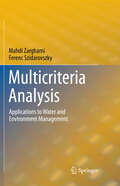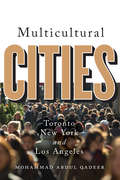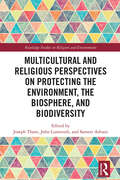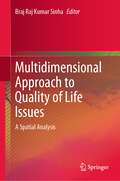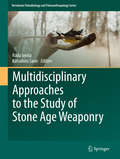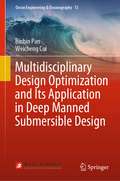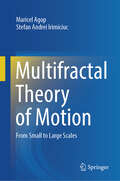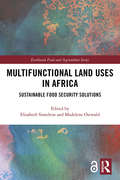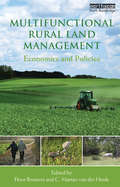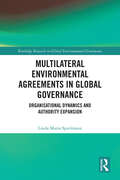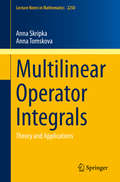- Table View
- List View
Multi-Hazard Early Warning and Disaster Risks
by Dilanthi Amaratunga Richard Haigh Nuwan DiasThis book presents a collection of papers under the theme of multi-hazard early warning and disaster risks. These were selected from the presentations made at the International Symposium on Tsunami and Multi-Hazard Risks, Early Warning and Community Awareness in supporting implementation of the Sendai Framework for Disaster Risk Reduction 2015-2030. This conference aimed to recognize achievements and to highlight work that still needs to be carried out. The conference promoted collaboration among academia, research institutions and disaster management offices, and further encouraged multidisciplinary and multi-sectoral interactionThis International Symposium on Multi-Hazard Early Warning and Disaster Risk Reduction provided an important opportunity to reflect upon our progress to date in tackling disaster risk, but also to consider some of the challenges and opportunities that lay ahead of us.A particular focus of this event wasMulti-Hazard Early Warning. During the negotiations for the Sendai Framework, countries and partners highlighted the need to:1. Continue to invest in, develop, maintain and strengthen people-centred, end-to-end early warning systems;2. Promote the application of simple and low cost early warning equipment and facilities;3. Broaden the dissemination channels for early warning information to facilitate early action.Countries also called for the further development of and investment in effective, nationally compatible, regional multi-hazard early warning mechanisms. To address these needs, global Target (g) of the Sendai Framework was adopted, namely to “substantially increase the availability of and access to multi-hazard early warning systems and disaster risk information and assessments to the people by 2030”. As illustrated by recent events in Indonesia, it is also vital to address the challenge of cascading hazards that pose a tsunami risk, and the importance of linking tsunami early warning to a multi-hazard environment. However, moving towards a multi-hazard environment is complex and poses many challenges but can bring significant benefits in terms of efficiencies and also in recognising the links between hazards, such as cascading threats. We very much hope that this book will provide an important platform to address these and other challenges in addressing disaster risk, as well as supporting implementation of the Sendai Framework for Disaster Risk Reduction
Multi-Scale Integrated Analysis of Agroecosystems (Advances In Agroecology Ser.)
by Mario GiampietroEcologists, agronomists, and others who may question the validity of current models for determining sustainable growth of agroecosystems, need a new set of analytical tools that more effectively address the complex nature of related processes. Those who challenge traditional assumptions of optimization and static factors in agricultural modeling de
Multi-finger Haptic Interaction
by Manuel Ferre Ignacio GalianaMulti-finger Haptic Interaction presents a panorama of technologies and methods for multi-finger haptic interaction, together with an analysis of the benefits and implications of adding multiple-fingers to haptic applications. Research topics covered include: design and control of advanced haptic devices;multi-contact point simulation algorithms;interaction techniques and implications in human perception when interacting with multiple fingers.These multi-disciplinary results are integrated into applications such as medical simulators for training manual skills, simulators for virtual prototyping and precise manipulations in remote environments. Multi-finger Haptic Interaction presents the current and potential applications that can be developed with these systems, and details the systems' complexity. The research is focused on enhancing haptic interaction by providing multiple contact points to the user. This state-of-the-art volume is oriented towards researchers who are involved in haptic device design, rendering methods and perception studies, as well as readers from different disciplines who are interested in applying multi-finger haptic technologies and methods to their field of interest.
Multi-physical and Non-orthogonal Geotechnical Plasticity Modeling and Algorithms
by Xiuli Du Dechun Lu Xin Zhou Jingyu LiangThis book primarily introduces innovative multi-physical plastic modeling for geomaterials in unsteady environments and advanced numerical methods for elastoplastic models, topics not systematically covered in other literature. The constitutive models in the form of stress-strain-environment will be interesting to students and researchers in geotechnical engineering and rock and soil mechanics. The book provides a thorough exploration of modeling techniques and algorithmic flowcharts, facilitating a deeper understanding of both theoretical models and numerical methods. It also guides readers in applying these tools to describe the mechanical behavior of geomaterials in various unsteady environments and addresses computational challenges in elastoplastic numerical analysis.
Multi-physics Coupling Analysis of Clayey Core Wall of High Earth-Rockfill Dam (Springer Theses)
by Yongkang WuNominated by Tsinghua University as an outstanding Ph.D. thesis, this book investigates the mechanical properties of unsaturated compacted clayey soil, the multi-field coupling consolidation theory of unsaturated soil and its application to a 261.5 m high earth-rockfill dam. It proposes a multi-field coupling analysis method of consolidation, and develops an efficient and practical finite element (FE) program for large-scale complex earth-rockfill dams. The book is primarily intended for researchers studying the multi-field coupling analysis of seepage consolidation.
Multi-risk Interactions Towards Resilient and Sustainable Cities (Advances in Sustainability Science and Technology)
by Tiago Miguel FerreiraFor years, researchers have studied the risks of individual natural hazards in urban areas. However, the impact of multiple hazards has not yet received widespread attention in research and urban management practice, which is a significant gap in the current climate change context. This book aims to contribute to filling that gap by examining the process of identifying, assessing, and managing multi-hazard risks in urban areas. From identifying and assessing the vulnerability of the elements exposed to the impact of natural hazards, including earthquakes, floods, fires, and landslides, this book covers all the critical stages of multi-hazard risk assessment and management in a climate change context. The concepts and approaches discussed in the book are applied to the Lisbon Metropolitan Area, a dynamic and thriving metropolis, allowing readers to see those theories applied in a real setting. In addition to providing a solid theoretical foundation, this book offers practical guidelines for conducting risk assessment at the metropolitan scale, which makes it a valuable resource for researchers, practitioners, and decision-makers interested in understanding and managing multi-hazard risks in urban areas.
Multi-scale Analysis for Random Quantum Systems with Interaction
by Yuri Suhov Victor ChulaevskyThe study of quantum disorder has generated considerable research activity in mathematics and physics over past 40 years. While single-particle models have been extensively studied at a rigorous mathematical level, little was known about systems of several interacting particles, let alone systems with positive spatial particle density. Creating a consistent theory of disorder in multi-particle quantum systems is an important and challenging problem that largely remains open. Multi-scale Analysis for Random Quantum Systems with Interaction presents the progress that had been recently achieved in this area. The main focus of the book is on a rigorous derivation of the multi-particle localization in a strong random external potential field. To make the presentation accessible to a wider audience, the authors restrict attention to a relatively simple tight-binding Anderson model on a cubic lattice Zd. This book includes the following cutting-edge features: an introduction to the state-of-the-art single-particle localization theory an extensive discussion of relevant technical aspects of the localization theory a thorough comparison of the multi-particle model with its single-particle counterpart a self-contained rigorous derivation of both spectral and dynamical localization in the multi-particle tight-binding Anderson model. Required mathematical background for the book includes a knowledge of functional calculus, spectral theory (essentially reduced to the case of finite matrices) and basic probability theory. This is an excellent text for a year-long graduate course or seminar in mathematical physics. It also can serve as a standard reference for specialists.
Multi-scale Quantitative Diagenesis and Impacts on Heterogeneity of Carbonate Reservoir Rocks
by Fadi Henri NaderThis book is both a review and a look to the future, highlighting challenges for better predicting quantitatively the impact of diagenesis on reservoir rocks. Classical diagenesis studies make use of a wide range of descriptive analytical techniques to explain specific, relatively time-framed fluid-rock interaction processes, and deduce their impacts on reservoir rocks. Future operational workflows will consist of constructing a conceptual diagenesis model, quantifying the related diagenetic phases, and modelling the diagenetic processes. Innovative approaches are emerging for applied quantitative diagenesis, providing numerical data that can be used by reservoir engineers as entry (input) data, and for validating results of numerical simulations. Geometry-based, geostatistical and geochemical modelling do not necessarily mimic natural processes, they rather provide reasonable solutions to specific problems.
Multi-scale Simulation of Composite Materials: Results from the Project MuSiKo (Mathematical Engineering)
by Stefan Diebels Sergej RjasanowDue to their high stiffness and strength and their good processing properties short fibre reinforced thermoplastics are well-established construction materials.Up to now, simulation of engineering parts consisting of short fibre reinforced thermoplastics has often been based on macroscopic phenomenological models, but deformations, damage and failure of composite materials strongly depend on their microstructure. The typical modes of failure of short fibre thermoplastics enriched with glass fibres are matrix failure, rupture of fibres and delamination, and pure macroscopic consideration is not sufficient to predict those effects. The typical predictive phenomenological models are complex and only available for very special failures. A quantitative prediction on how failure will change depending on the content and orientation of the fibres is generally not possible, and the direct involvement of the above effects in a numerical simulation requires multi-scale modelling.One the one hand, this makes it possible to take into account the properties of the matrix material and the fibre material, the microstructure of the composite in terms of fibre content, fibre orientation and shape as well as the properties of the interface between fibres and matrix. On the other hand, the multi-scale approach links these local properties to the global behaviour and forms the basis for the dimensioning and design of engineering components. Furthermore, multi-scale numerical simulations are required to allow efficient solution of the models when investigating three-dimensional problems of dimensioning engineering parts.Bringing together mathematical modelling, materials mechanics, numerical methods and experimental engineering, this book provides a unique overview of multi-scale modelling approaches, multi-scale simulations and experimental investigations of short fibre reinforced thermoplastics. The first chapters focus on two principal subjects: the mathematical and mechanical models governing composite properties and damage description. The subsequent chapters present numerical algorithms based on the Finite Element Method and the Boundary Element Method, both of which make explicit use of the composite’s microstructure. Further, the results of the numerical simulations are shown and compared to experimental results.Lastly, the book investigates deformation and failure of composite materials experimentally, explaining the applied methods and presenting the results for different volume fractions of fibres.This book is a valuable resource for applied mathematics, theoretical and experimental mechanical engineers as well as engineers in industry dealing with modelling and simulation of short fibre reinforced composites.
Multi-scale Understanding of Vegetation Ecosystems: Changes, Drivers and Inspirations
by Li Peng Tiantian ChenThis book highlights the vital role of vegetation in terrestrial surface systems, emphasizing its importance in regulating climate change, acting as a carbon sink, and maintaining the surface energy balance by absorbing CO2 from human activities. However, urbanization, extreme droughts, floods, fires, and other events negatively impact biodiversity, increase tree mortality, trigger wildfires, and exacerbate food insecurity and poverty. Understanding the influence of global climate change and human activity on vegetation patterns is essential. The structure and function of vegetation ecosystems result from interactions between natural ecological processes and socio-cultural factors, leading to variability across different spatial and temporal scales. While local-scale studies provide detailed insights, they are often difficult to generalize. Conversely, large-scale studies can inform comprehensive planning but may overlook nuances between subsystems. Therefore, enhancing research on the evolution of vegetation ecosystems and their responses to climate change across multiple scales is crucial to mitigate risks and maintain ecosystem balance. Extensive studies have explored the spatiotemporal dynamics and driving forces on large-scale vegetation structure, productivity, and resilience, especially on a global scale. However, there is limited research on vegetation characteristics in specific geological conditions and geomorphic regions, particularly in karst regions. Karst landforms account for 15% of the global vegetated land and are vital for global carbon and water cycles, as well as biodiversity conservation. Southwest China, the largest contiguous karst region, represents 0.36% of the vegetated land but contributes 5% of global aboveground biomass, making it a key carbon sink. However, its fragile ecological conditions, frequent extreme climate events, and unsustainable human activities have led to significant vegetation degradation and desertification, resulting in severe environmental damage in recent decades. To address these issues, ecological restoration measures have been launched since the early 2000s to boost vegetation.
Multi-sensor System Applications in the Everglades Ecosystem (Remote Sensing Applications Series)
by Caiyun ZhangThis book explores the applicability of multiple remote sensors to acquire information relevant to restoration and conservation efforts in wetlands using data collected from airborne and space multispectral/hyperspectral sensors, light detection and ranging (LiDAR), Unmanned Aircraft Systems (UAS), and a hand-held spectroradiometer. This book also examines digital data processing techniques such as object-based image analysis, machine learning, texture analysis, and data fusion. After an introduction to the Everglades and to remote sensing, the book is divided into four parts based on the sensor systems used. There are chapters on vegetation mapping, biomass and water quality modeling, applications of hyperspectral data for plant stress analysis and coral reef mapping, studies of airborne LiDAR data for coastal vulnerability analysis and DEM improvement, as well as chapters that explore a fusion of multiple sensors for different datasets. <p><p>Features <li>Introduces concepts, theories, and advanced processing techniques <li>A complete introduction of machine learning, object-based image analysis, data fusion, and ensemble analysis techniques in processing data from multiple remote sensors <li>Explains how multiple remote sensing systems are applied in the wetland ecosystems of Florida <li>The author had been teaching and using both systems and her research is widely recognized <p><p>Multi-sensor System Applications in the Everglades Ecosystems provides a comprehensive application of remote sensing techniques in the Florida Everglades and its coastal ecosystems. It will prove an invaluable resource for the restoration and conservation of the Florida Everglades and beyond, for global wetlands in general. Any professional, scientist, engineer, or student working with remote sensing and wetland ecosystems will reap enormous benefits from this book.
Multi-stakeholder Processes for Governance and Sustainability: Beyond Deadlock and Conflict
by Minu HemmatiGovernments, business, international bodies and local groups are turning to multi-stakeholder processes to find practical ways forward. This book explains how MSPs can be organized to deliver their potential for successful resolution of complex issues and for sustainable development. It includes detailed examples and provides practical checklists, explaining how to get beyond adversarial politics and achieve positive results.
Multicriteria Analysis: Applications to Water and Environment Management
by Ferenc Szidarovszky Mahdi ZarghamiMulticriteria analysis is one of the most important fields of decision science. This book gives an outline of the formulation of an appropriate model and presents a comprehensive summary of the most popular methods for solving multicriteria decision problems. In addition to the classical approach the book introduces fuzzy and stochastic methodology, models with uncertainty, social choice and conflict resolution. All methods are illustrated with easy to follow simple examples. At the end of each chapter detailed case studies are given in water and environment management including inter-basin water transfer, urban water management, water allocation, groundwater quality management, forest treatment, ranking water resources projects, reservoir planning, water distribution network design and long-term watershed management. The new methodology and the wide variety of case studies are not easily accessible elsewhere.
Multicultural Cities: Toronto, New York, and Los Angeles
by Mohammed Abdul QadeerWhat defines a multicultural city? Policy? Geography? Demography? In Multicultural Cities, Mohammad Abdul Qadeer offers a tour of three of North America's premier multicultural metropolises - Toronto, New York, and Los Angeles - that demonstrates the critical qualities that make these cities multicultural.Guided by the perspective that multiculturalism is the combination of cultural diversity with a common ground of values and institutions, Qadeer examines the social geography, economy, and everyday life of each metropolitan area. His analysis spans the divide between Canada, where multiculturalism is official government policy, and the United States, where it is not. A comprehensive investigation of how some of today's leading majority-minority cities thrive, written by a keen observer of North American urban life, Multicultural Cities is an important complement to any discussion about how cities can and should accommodate diversity.
Multicultural and Religious Perspectives on Protecting the Environment, the Biosphere, and Biodiversity (Routledge Studies in Religion and Environment)
by Joseph Tham John Lunstroth Sameer AdvaniThis thought-provoking volume unites bioethics experts from seven major world religions—Buddhism, Christianity, Confucianism, Daoism, Hinduism, Islam, and Judaism—alongside secular thinkers to explore environmental protection through the lens of the UNESCO Declaration on Bioethics and Human Rights. It foregrounds the power of diverse perspectives in addressing one of humanity's most pressing challenges—the ecological crisis. The contributions provide rich and distinct religious and cultural viewpoints as they confront the anthropological, ethical and social dimensions of this crisis. Showcasing dialogue where traditions and philosophies collide, they offer unique insights into global bioethics and human rights that should inspire new ways of thinking and foster meaningful collaboration in the fight for our planet's future. The book is valuable reading for researchers, scholars and students in bioethics, environmental ethics, religious studies and beyond.
Multidimensional Approach to Quality of Life Issues: A Spatial Analysis
by Braj Raj Kumar SinhaThis comprehensive volume provides a broad overview of quality of life issues covering a wide geographical region: North America, Europe, parts of Africa, East Asia, and South Asia. Spread over more than 25 chapters, it includes the latest findings from these regions to provide a multidisciplinary account of the major dimensions of quality of life, and therefore has a vast scope. The volume is divided into four thematic parts: theoretical dimension; Demographic dimension; socio-cultural and economic dimensions; and urban and environment related dimensions. Extensive maps, diagrams and tables accompany the discussions and facilitate understanding. This is an indispensable reference and serves the interest of students and scholars of human geography, economics, demography, sociology, anthropology, social work, and philosophy. It is particularly useful for those engaged in further research on quality of life issues.
Multidimensional Periodic Schrödinger Operator: Perturbation Theories for High Energy Regions and Their Applications (Springer Tracts in Modern Physics #291)
by Oktay VelievThis book describes the direct and inverse problems of the multidimensional Schrödinger operator with a periodic potential, a topic that is especially important in perturbation theory, constructive determination of spectral invariants and finding the periodic potential from the given Bloch eigenvalues. It provides a detailed derivation of the asymptotic formulas for Bloch eigenvalues and Bloch functions in arbitrary dimensions while constructing and estimating the measure of the iso-energetic surfaces in the high-energy regime. Moreover, it presents a unique method proving the validity of the Bethe–Sommerfeld conjecture for arbitrary dimensions and arbitrary lattices. Using the perturbation theory constructed, it determines the spectral invariants of the multidimensional operator from the given Bloch eigenvalues. Some of these invariants are explicitly expressed by the Fourier coefficients of the potential, making it possible to determine the potential constructively using Bloch eigenvalues as input data. Lastly, the book presents an algorithm for the unique determination of the potential.This updated and significantly expanded third edition features an extension of this framework to all dimensions, offering a now complete theory of self-adjoint Schrödinger operators within periodic potentials. Drawing from recent advancements in mathematical analysis, this edition delves even deeper into the intricacies of the subject. It explores the connections between the multidimensional Schrödinger operator, periodic potentials, and other fundamental areas of mathematical physics. The book's comprehensive approach equips both students and researchers with the tools to tackle complex problems and contribute to the ongoing exploration of quantum phenomena.
Multidimensional Periodic Schrödinger Operator: Perturbation Theory and Applications
by Oktay VelievThis book describes the direct and inverse problems of the multidimensional Schrödinger operator with a periodic potential, a topic that is especially important in perturbation theory, constructive determination of spectral invariants and finding the periodic potential from the given Bloch eigenvalues. It provides a detailed derivation of the asymptotic formulas for Bloch eigenvalues and Bloch functions in arbitrary dimensions while constructing and estimating the measure of the iso-energetic surfaces in the high-energy regime. Moreover, it presents a unique method proving the validity of the Bethe–Sommerfeld conjecture for arbitrary dimensions and arbitrary lattices. Using the perturbation theory constructed, it determines the spectral invariants of the multidimensional operator from the given Bloch eigenvalues. Some of these invariants are explicitly expressed by the Fourier coefficients of the potential, making it possible to determine the potential constructively using Bloch eigenvalues as input data. Lastly, the book presents an algorithm for the unique determination of the potential. This updated second edition includes an additional chapter that specifically focuses on lower-dimensional cases, providing the basis for the higher-dimensional considerations of the chapters that follow.
Multidisciplinary Approaches to the Study of Stone Age Weaponry
by Radu Iovita Katsuhiro SanoThe objective of this volume is to showcase the contemporary state of research on recognizing and evaluating the performance of stone age weapons from a variety of viewpoints, including investigating their cognitive and evolutionary significance. New archaeological finds and experimental studies have helped to bring this subject back to the forefront of human origins research. In the last few years, investigations have expanded beyond examining the tools themselves to include studies of damage caused by projectile weapons on animal and hominin bones and skeletal asymmetries in ancient hominin populations. Only recently has there been a growing interest in controlled and replicative experiments. Through this book readers will be updated in the state of knowledge through a multidisciplinary scientific reconstruction of prehistoric weapon use and its implications. Contributions from expert authors are organized into three themed parts: recognizing weapon use (experimental and archaeological studies of impact traces), performance of weapon systems (factors influencing penetration depth etc. ), and behavioral and evolutionary ramifications (cognitive and ecological effects of using different weapons).
Multidisciplinary Design Optimization and Its Application in Deep Manned Submersible Design (Ocean Engineering & Oceanography #13)
by Weicheng Cui Binbin PanThis book investigates Reliability-based Multidisciplinary Design Optimization (RBMDO) theory and its application in the design of deep manned submersibles (DMSs). Multidisciplinary Design Optimization (MDO) is an effective design method for large engineering systems like aircraft, warships, and satellites, which require designers and engineers from various disciplines to cooperate with each other. MDO can be used to handle the conflicts that arise between these disciplines, and focuses on the optimal design of the system as a whole. However, it can also push designs to the brink of failure. In order to keep the system balanced, Reliability-based Design (RBD) must be incorporated into MDO. Consequently, new algorithms and methods have to be developed for RBMDO theory.This book provides an essential overview of MDO, RBD, and RBMDO and subsequently introduces key algorithms and methods by means of case analyses. In closing, it introduces readers to the design of DMSs and applies RBMDO methods to the design of the manned hull and the general concept design. The book is intended for all students and researchers who are interested in system design theory, and for engineers working on large, complex engineering systems.
Multifractal Theory of Motion: From Small to Large Scales
by Maricel Agop Stefan Andrei IrimiciucThis book aims to present the topic of nonlinear and chaotic dynamics in a manner that is useful and beneficial to students and young researchers from various domains such as physics, mathematics, biology, or even medicine. A very important aspect of that topic is that the constraints of determinism do not imply a regular behavior or do not rely on predictability in describing the dynamics of natural systems. Exploring the evolution of natural systems has a great impact nowadays on a wide range of scientific domains. The dynamics of populations, cardiac fibrillation, communication systems, fluid flow, and atmospheric systems are just a few topics in which nonlinearity and chaos are a regular manifestation. This leads to the idea that it is necessary to find universal laws that govern these dynamics. The aforementioned variety in scientific topics is also sustained by an exponential interest in recent decades from readers in the scientific community and the non-scientific one as well. The book is devoted to the nonlinear and chaotic dynamics topic, a domain that is both trans- and multi-disciplinary and has been the focus of the scientific community in past decades.
Multifunctional Land Uses in Africa: Sustainable Food Security Solutions (Earthscan Food and Agriculture)
by Elisabeth Simelton Madelene OstwaldThis book presents contemporary case studies of land use, management practices, and innovation in Africa with a view to exploring how multifunctional land uses can alleviate food insecurity and poverty. Food security and livelihoods in Africa face multiple challenges in the form of feeding a growing population on declining land areas under the impacts of climate change. The overall question is what kind of farming systems can provide resilient livelihoods? This volume presents a selection of existing farming systems that demonstrate how more efficient use of land and natural resources, labour and other inputs can have positive effects on household food security and livelihoods. It examines how aquaculture, integrated water management, peri-urban farming systems, climate-smart agriculture practices and parkland agroforestry contribute multiple benefits. Drawing on case studies from Kenya, Ethiopia, Nigeria and Burkina Faso, contributed by young African scientists, this book provides a unique perspective on multifunctional land use in Africa and illustrates how non-conventional uses can be profitable while promoting social and environmental sustainability. Tapping into the global discussion on land scarcity and linking food security to existing land use change processes, this volume will stimulate readers looking for diversified land uses that are compatible with both household and national food security ambitions. This book will be of great interest to students and scholars of African development, agriculture, food security, land use and environmental management, as well as sustainable development more generally, in addition to policymakers and practitioners working in these areas.
Multifunctional Rural Land Management: Economics and Policies
by C. Martijn van der Heide Brouwer FloorThe increasing demand for rural land and its natural resources is creating competition and conflicts. Many interested parties, including farmers, nature conservationists, rural residents and tourists, compete for the same space. Especially in densely populated areas, agriculture, recreation, urban and suburban growth and infrastructure development exert a constant pressure on rural areas. Because land is a finite resource, spatial policies which are formulated and implemented to increase the area allocated to one use imply a decrease in land available for other uses. As a result, at many locations, multi-purpose land use is becoming increasingly important. This notion of multi-purpose land use is reflected in the term 'multifunctionality'. This volume provides insights into viable strategies of sustainable management practices allowing multiple functions sustained by agriculture and natural resources in rural areas. It shows how the rural economy and policies can balance and cope with these competing demands and includes numerous case studies from Europe, North America and developing countries.
Multilateral Environmental Agreements in Global Governance: Organisational Dynamics and Authority Expansion (Routledge Research in Global Environmental Governance)
by Linda Maria SpielmannThis book proposes a conceptualisation of Multilateral Environmental Agreements as a form of International Organisations, exploring the ways in which they have expanded over time by discussing the nuances of authority in global governance.Multilateral Environmental Agreements are the key type of cooperation between states to address environmental concerns globally. While their activities regularly attract much attention from an academic and non-academic audience, their peculiar hybrid nature in-between treaties and full-fledged International Organisations, means they are often underestimated. This book proposes a new and innovative conceptualisation of Multilateral Environmental Agreements as a specific type of International Organisation which allows for a more accurate understanding of their dynamic nature, and uncovers expansive tendencies which have so far gone almost completely unnoticed. Based on a modern understanding of authority in global governance, the book shows how Multilateral Environmental Agreements represent a separate entity, and expand beyond the boundaries originally set by their member states. The book draws upon the neo-functionalist concept of spillover, as well as multiple other theoretical frameworks, to identify the two main drivers of expansion in Multilateral Environmental Agreements. To illustrate these drivers, the empirical chapters conduct six structured case studies, analysing specific cases of authority expansion in ozone and climate protection, including the Green Climate Fund under the UN Framework Convention on Climate Change. Overall, this book offers an invaluable contribution to the theoretical discussion on informal types of organisations, and provides new and extensive empirical insights into unexpected past and recent developments in global environmental governance.As such, this book will be of great interest to students and scholars of International Relations and International Law who focus on informal types of cooperation and legislation, dynamic institutional development, and international environmental politics generally.
Multilinear Operator Integrals: Theory and Applications (Lecture Notes in Mathematics #2250)
by Anna Skripka Anna TomskovaThis book provides a comprehensive treatment of multilinear operator integral techniques. The exposition is structured to be suitable for a course on methods and applications of multilinear operator integrals and also as a research aid. The ideas and contributions to the field are surveyed and up-to-date results and methods are presented. Most practical constructions of multiple operator integrals are included along with fundamental technical results and major applications to smoothness properties of operator functions (Lipschitz and Hölder continuity, differentiability), approximation of operator functions, spectral shift functions, spectral flow in the setting of noncommutative geometry, quantum differentiability, and differentiability of noncommutative L^p-norms. Main ideas are demonstrated in simpler cases, while more involved, technical proofs are outlined and supplemented with references. Selected open problems in the field are also presented.
